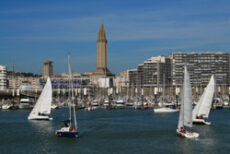
A Unesco World Heritage Site since 2005, Le Havre is a love letter to modernism, evoking, more than any other French city, France’s postwar energy and optimism. The centre was completely rebuilt by the Belgian architect Auguste Perret, whose bright, airy modernist vision remains, miraculously, largely intact. The most striking example of Perret’s architecture is the concrete Eglise St Joseph, shaped like a lighthouse, with 12,768 pieces of coloured glass inside the 107m high octagonal lantern tower where the colours reflected differ throughout the day due to the placement of the sun. Built to commemorate the victims of the Allied bombings in 1944, it is an architectural masterpiece of the 20th century and is well worth visiting. The 16th century cathedral is one of the few buildings left of that era that survived the bombing although it did suffer damage. At the Appartement Témoin, a show apartment from the 1950s, you can discover what life was like in the 50s at the birth of consumerism and mass-production.
Numerous museums and galleries provide cultural interest, and in summer, there are several beaches for the sun-seekers.